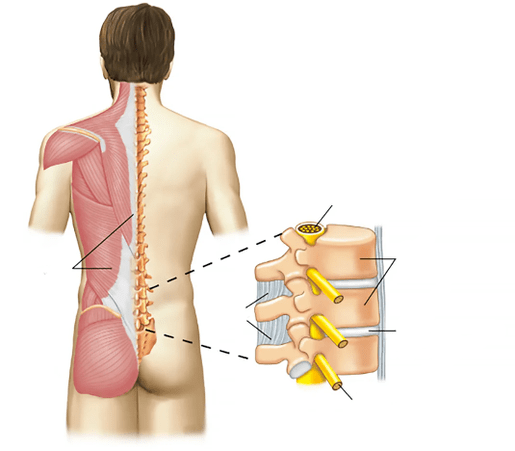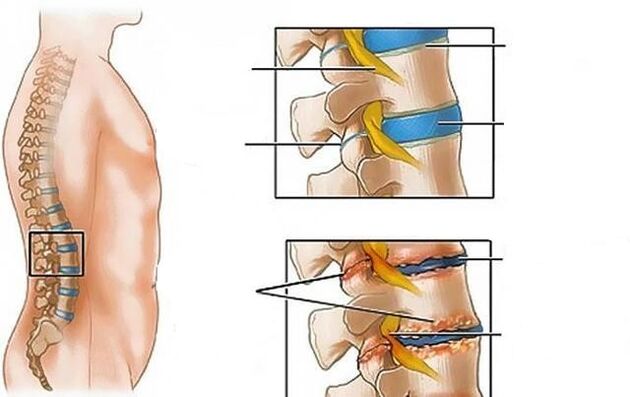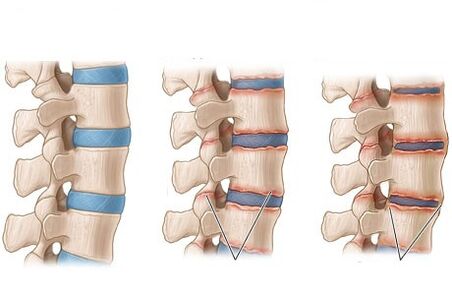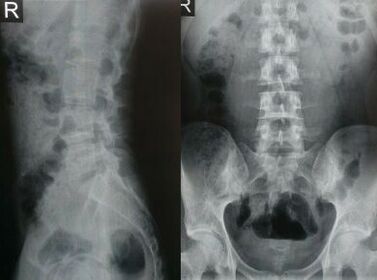Usually, lumbar pain indicates the development of pathology, including the beginning of the inflammatory process. If treatment is not started in time, the symptoms will worsen and it will be more difficult to restore health. In this article, you will learn about the causes and treatments of lumbar pain.
If treatment is not started in time, the symptoms will worsen and it will be more difficult to restore health. In this article, you will learn about the causes and treatments of lumbar pain.
Features of low back pain
According to the nature, pain is divided into 3 types:
Chronic.A person feels discomfort during any physical activity-bending over, climbing stairs or twisting the body. During the recurrence (worsening), the pain will intensify and affect all parts of the body.
sharp.It occurs when the intervertebral disc is displaced and is characterized by severe pain in the lower back. Mobility is inconvenient, a person cannot get up, it is difficult to walk or bend over.
pain.It is accompanied by an unpleasant feeling that will not disappear for a long time. Usually, pain heralds the development of kidney, genitourinary system diseases. It may also be a symptom of osteochondrosis, spondyloarthropathy, and spondyloarthritis.

In addition to lumbar pain and discomfort, patients may experience the following accompanying symptoms:
- Muscle weakness;
- Inability to control urination and defecation;
- Numbness in the legs;
- Increased body temperature;
- Chills
- Groin/crotch pain;
- Violation of the menstrual cycle.
If the discomfort does not go away for a long time and a person complains of several symptoms at the same time, it is important to contact the therapist immediately. Only a doctor can make a correct diagnosis and prescribe treatment.
Causes of low back pain
Lumbar pain syndrome is mainly caused by two major types of diseases:
Spine problems:
Osteochondrosis.Degenerative dystrophy disease in which the intervertebral disc loses its flexibility and ability to function properly. The disease can be cured in the early stage and needs timely treatment. Severe pain and increased bending indicate the progressive development of the disease.

Spondylosis.A disease of the spine in which the intervertebral discs are severely depleted and worn out. The pathological cause is trauma and increased spine pressure. People with spondylopathy have difficulty turning their bodies. The disease is characterized by a slow course, so treatment results are usually positive.
Scoliosis.Curvature of the spine, due to rapid growth, most often occurs during puberty. The disease has 4 stages and can manifest as lower back pain.
Low back pain.Sudden pain in the lumbar spine, in this case, a person freezes in an uncomfortable position. The mobility of low back pain is also limited.
Osteoporosis.A serious pathology in which the bone vertebrae become porous, losing density and elasticity. Low back pain may occur when lifting weights, changing posture, and other loads.
Systemic arthropathyAmong them, a person will feel stiffness, soreness and tension in the back muscles in the waist area. These unpleasant feelings can be exacerbated at night and cause frequent waking. Exercise and exercise can relieve pain.

Myofascial syndrome.A fairly common disease caused by uncomfortable posture or physical exertion for a long time. A distinguishing feature is the presence of trigger (pain) points in the lower back or buttocks. When they are pressed, severe pain occurs.
Visceral diseases:
Attack of appendicitis.According to the characteristics of the human body, the pain may appear on the right side and appear on the lower back.
Kidney inflammation.The main symptoms of impaired renal function are waist stretch and unpleasant pain. It may also be accompanied by the appearance of edema and increased body temperature.
pancreatitisAs the disease progresses, a person may experience nausea, vomiting, and stomach upset. If the lower back pain is caused by pancreatitis, the pain will not increase when palpating the spine.
cholecystitis.The pain is located on the right side and radiates to the lower back at the same time. Low back pain and waist discomfort indicate that spinal nerve fibers are involved in the pathological process.
EndometriosisA gynecological disease in which the inner cell growth of the parietal layer of the uterus exceeds its limit. This woman is experiencing waist pain.
obesity.Being overweight can put unnecessary pressure on the lower back and intervertebral discs. As a result, they deform and collapse. A person feels discomfort when walking or climbing stairs for a long time.
Oncology.If there are benign or malignant tumors, low back pain may occur. It "absorbs" a lot of calcium, the bone structure is lacking, and they become thinner.
Physiological causes of low back pain
Low temperature. Prolonged exposure to fresh air in cold weather can cause numbness in the lower back. At the same time, the discomfort when bending, moving and turning will increase. Sometimes she can give in her legs or hips.
Crucial day. During the menstrual cycle, about 50% of women experience unpleasant and tugging sensations in the lower abdomen, and these sensations extend to the waist area. Usually, the discomfort will disappear after the cycle ends.
The load is too large. Excessive weightlifting and waist pressure can cause pain.
climax. During menopause, the level of estrogen (a hormone that regulates the recovery process) in a woman's body will decrease. Bone tissue loses its ability to fully recover. They become brittle.
The shoes are not convenient. Wearing high heels and tight shoes will compress the blood vessels in the legs. As a result, low back pain occurred.
Lack of physical activity. A sedentary lifestyle and lack of exercise can cause chronic low back pain. Muscles shrink and lose their natural elasticity.
diagnosis
First, the doctor meets and examines the patient. He requires general chemical analysis (donation of blood and urine). To obtain a general picture and rule out serious pathological changes, it is recommended to pass:
CT.A modern diagnostic method that you can use to detect the development of pathology at an early stage. He clearly visualized all skeletal structures.
Nuclear magnetic resonance.Shows the state of soft tissue and cartilage. In addition, with the help of MRI, tumors, intervertebral hernias and vascular changes can be diagnosed.
X-ray.Provides information about changes in the bone structure of the spine, shows whether there are bruises, microcracks, and helps detect spinal diseases.
Ultrasound.Allows you to determine the state of internal organs and detect inflammatory processes.

Based on the data obtained, the doctor makes a diagnosis and prescribes a treatment plan. If necessary, he will suggest that other experts conduct an examination: gynecologist, endocrinologist, gastroenterologist.
How to treat low back pain
The method of treatment depends on the disease and is prescribed separately. Generally, comprehensive therapy is the most effective. They usually recommend:
- Avoid lifting heavy objects;
- Take B vitamins and calcium;
- Use a support bandage;
- Swimming, exercising more or participating in medical gymnastics courses;
- Take corticosteroids to relieve severe inflammation (as directed by your doctor);
- Muscle relaxants to relieve cramps.
Depending on the cause of the disease, the doctor may require bed rest, or conversely, increase physical activity. For example, if the nerve is squeezed, it is recommended to rest passively. For some muscle cramps, massage and moderate exercise. In addition, treatment methods include:
physiotherapy.Including a variety of methods to physically affect the affected area. With its help, microcirculation is improved, edema and spasm disappear, and anti-inflammatory effects can be achieved.
Manipulative therapy.An alternative medicine used to treat the musculoskeletal system. The expert finds the place where the nerve is clamped and helps the spasm muscle to relax. It can also set the tone for places that, on the contrary, are very relaxing.
acupuncture.Help relieve pain by using special needles. They are injected into the body and spine. The muscles relax and the lower back becomes healthier.
When conservative treatment fails, it is necessary to consult a neurosurgeon. In most cases, surgery is performed for intervertebral hernia, which can cause invasion of the spinal cord and radicular pain.
What to do with severe back pain
For intolerable acute low back pain, give the patient a blocker. The process in which a doctor injects painkillers into areas where pain occurs or nerve fibers pass through. This radical approach can temporarily relieve pain. In addition, experts may prescribe antibiotics, immunomodulators, and chondroprotective agents.
For severe back pain, do not self-medicate or endure it. This can lead to fatal consequences, including disability or death.
Prevention and prognosis
Try to maintain a balance between work and play. A sedentary lifestyle and lack of physical exercise are the main causes of back pain.
If you work or drive at the computer all day, try to find time to exercise or take a walk. There is no need to stay in the hall for two hours. You can choose a viable exercise from yoga, fitness or Pilates and do it at home.
Carry heavy objects in a backpack. This will help evenly distribute the load on the back instead of tearing it off. When lifting heavy objects, bend your legs, not your back. If you need to reach from above, use a ladder or chair.
Give it a massage. Visit the massage therapist twice a year and receive at least 10 massage sessions. This will help relieve muscle cramps and promote overall health.
Get an orthopedic mattress and pillow. In the dream, a person spent the ⅓ of his life. Make sure you feel comfortable and can relax completely during this time. After consulting the seller, buy the product in a plastic surgery salon.
In order not to hurt yourself, please pay attention to traditional medicine and self-medication methods. If you need expert help, you can contact our clinic. To make an appointment, please leave a request or call.























